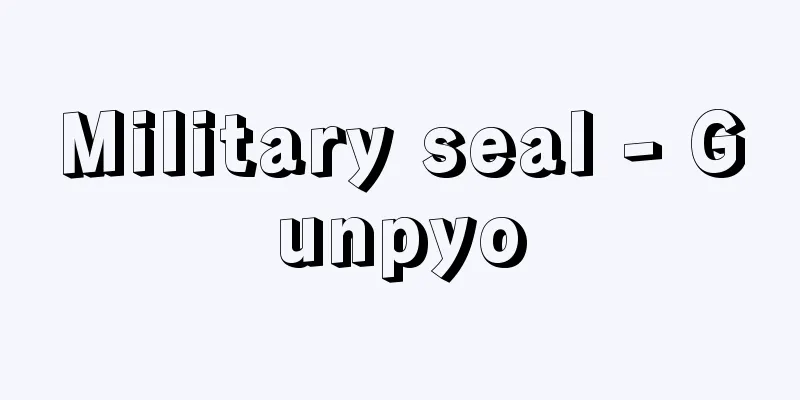Military seal - Gunpyo

|
A special currency issued by the government or military during wartime, mainly to pay for supplies and labor necessary for military operations in occupied territories, and to pay the salaries and wages of soldiers and military personnel. It is also called military bills, military tickets, military notes, or payment certificates, and military bills are an abbreviation of military bills. The currency unit can be the currency unit of the home country or the currency unit of the occupied local area, with the latter being the most common. In times of war, if the home country's currency was used in occupied territories, it would cause problems such as a decline in the value of the home country's currency due to increased issuance, financial confusion, local circulation problems, differences in currency standards, and transportation difficulties, so it is issued and used with a new design separately from the military budget. In principle, it is settled with the home country's currency after the end of the war, but it can become worthless if the issuing country is defeated. Historically, it began to be used by Chinese warlords in the 19th century, and was issued by the Allied forces and German forces in World War I and World War II. In Japan, the first notes were issued by Saigo's army during the Satsuma Rebellion, and were subsequently used in the Russo-Japanese War, the Siberian Intervention, the Second Sino-Japanese War, the Greater East Asia War, etc. The units of military notes issued by the Ministry of Finance during the Greater East Asia War were peso, centavo (Philippines), dollar, cent (Malaysia), pound, shilling (Oceania), rupee, cent (Burma), gulden, rupiah, cent (Indonesia), etc. [Terada Chikao] "Illustrated Guide to Japanese Military Currency Notes" by Tamotsu Ohta (1976, International Coin Club) "Japanese Military Currency Notes" by Chikao Terada (1987, Ad Uni, Fuji Publishing Co., Ltd.) Source: Shogakukan Encyclopedia Nipponica About Encyclopedia Nipponica Information | Legend |
|
戦争に際して主として占領地で軍の作戦行動に必要な物資や労力への支払い、軍人・軍属の俸給・給与の支払いに用いるため、政府または軍が発行する特殊通貨。軍用手票(しゅひょう)、軍用切符、軍札、仕払証票とも称し、軍票は軍用手票の略。通貨単位は、本国通貨単位の場合と占領現地通貨単位の場合とがあり、概して後者の例が多い。戦時に際し、占領地で本国通貨を使用すると、増発による本国通貨価値の低下および財政の混乱、現地流通の障害、通貨基準の違い、輸送困難などの弊害が生じるため、軍事予算とは別枠で新規のデザインで発行使用される。原則として終戦後、本国通貨により精算される決まりだが、発行国が敗戦のときには無価値となることがある。歴史的には19世紀、中国軍閥が使用し始め、第一次、第二次世界大戦で連合軍、ドイツ軍がそれぞれ発行した。 日本では西南戦争に西郷軍が発行した西郷札が最初で、以後日露戦争、シベリア出兵、日中戦争、大東亜戦争などで使用した。大東亜戦軍票(大蔵省発行)の単位は、ペソ、センタボ(フィリピン)、ドル、セント(マレー)、ポンド、シリング(オセアニア)、ルピー、セント(ビルマ)、グルデン、ルピア、セント(インドネシア)などである。 [寺田近雄] 『太田保著『日本紙幣軍票図鑑』(1976・万国コインクラブ)』▽『寺田近雄著『日本の軍票』(1987・アド・ユニ、不二出版販売)』 出典 小学館 日本大百科全書(ニッポニカ)日本大百科全書(ニッポニカ)について 情報 | 凡例 |
>>: Kumbi Saleh (English spelling)
Recommend
Okutsu [Hot Spring] - Okutsu
...Located in the mountainous area upstream of th...
Cayenne (Plant) (English spelling) Cayenne
…var. longum (English name: long pepper) produces...
Urasugishi - Urasugishi
…The cedars on the Japan Sea side also show the m...
Cavitation number
...When it occurs in a vortex, it becomes a long,...
Extrinsic variable stars
...QZ is the 334th, and from the 335th, the Roman...
Rock stress - rock stress
… In addition to the tests on the mechanical prop...
Genzaemon Sano - Genzaemon Sano
A fictitious name. He is said to have been a resid...
Luminance - luminance
A quantity that expresses the degree of brillianc...
Stuart, J.
In the 1890s, the world was divided into two comp...
Tagalog - Tagalog (English spelling) Tagalog
One of the major ethnic groups in the Philippines....
Managed floating exchange rate system
…This market intervention is called a smoothing o...
FT 30 Common Industrial Stock Index - FT 30 Common Industrial Stock Index
…[Masayuki Sato]. … *Some of the terminology used...
I.D. reaction - I.D. reaction
...A disease characterized by the occurrence of n...
Red Gentian - Red Gentian
...It is mainly distributed in the Hakuba mountai...
âğıt (English spelling) agit
…Folk songs can be divided into two contrasting s...









